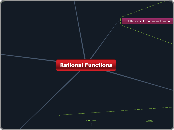MAT.126
1.2-1.3
1.3 Evaluating Limits Analytically
Evaluate a limit using the Squeeze Theorem
Theorem 1.9
Two Special Trigonometric Limits
Theorem 1.8
The Squeeze Theorem
p. 65
Evaluate a limit using dividing out and rationalizing techniques
Rationalizing
Use when rational limits with radicals have the form 0/0 after direct substitution.
The expression 0/0 is indeterminate.
Theorem 1.7 allows this method to work.
Dividing Out
Use when rational limits have the form 0/0 after direct substitution.
The expression 0/0 is indeterminate.
Think "simplify."
Theorem 1.7 allows this method to work.
Develop and use a strategy for finding limits
A Strategy for Finding Limits
Learn to recognize which limits can be evaluated by direct substitution (Theorems 1.1-1.6).
If the limit of f(x) as x approaches c cannot be evaluated by direct substitution, try to find a function g that agrees with f for all x other than x=c. [Choose g such that the limit of g(x) can be evaluated by direct substitution.]
Apply Theorem 1.7 to conclude analytically that your choice of g works.
Use a graph or table to reinforce your conclusion.
Theorem 1.7
Functions That Agree At All But One Point
p.62
Evaluate a limit using properties of limits
Theorem 1.6
Limits of Trigonometric Functions
Theorem 1.5
The Limit of a Composite Function
p. 61
Theorem 1.4
The Limit of a Function Involving a Radical
Theorem 1.3
Limits of Polynomials and Rational Functions
p. 60
Theorem 1.2
Properties of Limits
Theorem 1.1
Some Basic Limits
p. 59
1.2 Finding Limits Graphically and Numerically
Study and use a formal definition of limit
Epsilon-Delta definition of limit
Learn different ways that a limit can fail to exist
Oscillating behavior
Dirichlet function
Unbounded behavior
Behavior that differs from the right and from the left
Estimate a limit using a numerical or graphical approach
Existence of f(x)
The existence or nonexistence of f(x) at x=c has no bearing on the existence of the limit of f(x) as x approaches c.
Notation
Graphical approach
Does the graph show a large irregularity of some sort?
Numerical approach
Use a table of values that approach the value of interest from both sides.









